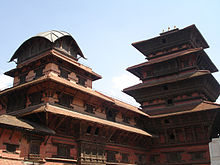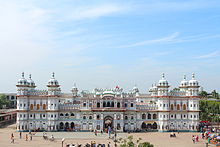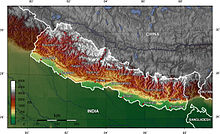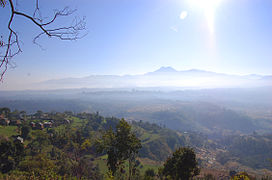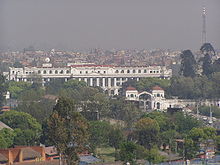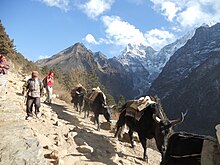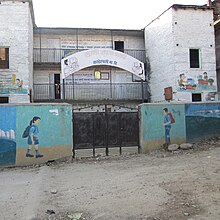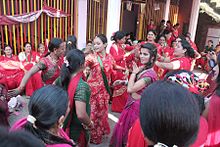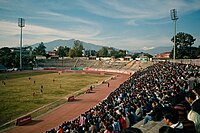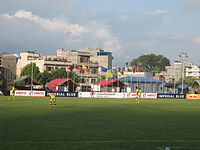Geography
Nepal is in Southern Asia,
between China and India. It covers total area of 143,351 sq km and its
boundary is 2,926 km long in total, bordered by China 1,236 km and India
1,690 km. It is a landlocked country.
The weather and climate
varies from hot summers to severe winters. Nepal has varieties of lands
as it has weather and people. The land starts from 70m from sea level
from Kanchan Kalan in Terai and passes though hilly region to the
world's highest point Mount Everest at 8,850 m.
Nepal is known for its
natural beauty and it has its own cultures. It has more than
70 ethnic groups and more than 60 different languages are spoken in
different parts of Nepal. Nepali is the national language of Nepal.
People practice several religion. Till now Hinduism and Buddhism have the largest population.
Kathmandu is the capital, and Nepal has 30 millions people.
Flag of Nepal
Nepal
(नेपाल) has its flag red with a blue border around the unique shape of
two overlapping right triangles. The smaller, upper triangle has a
white stylized moon and the larger and lower triangle displays a white
12-pointed sun. The color red represents the rhododendron (the National
flower of Nepal) and the color red is sign of victory and bravery. The
blue border signifies peace and harmony; the two right triangles are a
combination of two single pennons (pennants) that originally symbolized
the Himalaya Mountains. The moon represents the serenity of the
Nepalese people and the shade and cool weather in the Himalayas, while
the sun depicts the heat and higher temperatures of the lower parts of
Nepal. The moon and the sun are also said to express the strong belief
that the Nepal will be there in the earth as long as Sun and Moon are in
the sky.
Nepal is the only country in the world with triangular flag.
From Wikipedia
This article is about the country. For other uses, see Nepal
| Federal Democratic Republic of Nepal
सङ्घीय लोकतान्त्रिक गणतन्त्र नेपाल
Sanghiya Loktāntrik Ganatantra Nepāl |
||||||
|---|---|---|---|---|---|---|
|
||||||
| Motto: जननी जन्मभूमिश्च स्वर्गादपि गरीयसी (Sanskrit) "Mother and Motherland are Greater than Heaven" |
||||||
| Anthem: Sayaun Thunga Phulka "Made of Hundreds of Flowers" |
||||||
| Capital and largest city |
Kathmandu (Nepali: काठमाडौं) 27°42′N 85°19′E |
|||||
| Official languages | Nepali | |||||
| Recognised regional languages | Newar, Tharu, Gurung, Tamang, Magar, Awadhi, Sherpa, Kiranti, Rai, Limbu, Maithili, Bhojpuri, Bodo | |||||
| Religion | 80% Hindu 10% Buddhist 5% Muslim 5% Kirant Mundhum, Christian, and others |
|||||
| Demonym | Nepali, Nepalese, Gurkhas | |||||
| Government | Federal parliamentary republic | |||||
| - | President | Ram Baran Yadav | ||||
| - | Vice President | Parmanand Jha | ||||
| - | Prime Minister | Sushil Koirala | ||||
| Legislature | Constituent Assembly | |||||
| Unification | ||||||
| - | Kingdom declared | 25 September 1768[1] | ||||
| - | State declared | 15 January 2007 | ||||
| - | Republic declared | 28 May 2008 | ||||
| Area | ||||||
| - | Total | 147,181 km2 (95th) 56,827 sq mi |
||||
| - | Water (%) | 2.8 | ||||
| Population | ||||||
| - | 2011 census | 26,494,504[2] | ||||
| - | Density | 180/km2 (62nd) 518/sq mi |
||||
| GDP (PPP) | 2013 estimate | |||||
| - | Total | $62.384 billion[3] | ||||
| - | Per capita | $2,310 [4] | ||||
| GDP (nominal) | 2012 estimate | |||||
| - | Total | $19.921 billion[5] | ||||
| - | Per capita | $743[5] | ||||
| Gini (2010) | 32.8[6] medium |
|||||
| HDI (2014) | low · 145th |
|||||
| Currency | Nepalese Rupee (NPR) | |||||
| Time zone | NPT (UTC+05:45) | |||||
| DST not observed | ||||||
| Drives on the | left | |||||
| Calling code | +977 | |||||
| ISO 3166 code | NP | |||||
| Internet TLD | .np | |||||
The mountainous north of Nepal has eight of the world's ten tallest mountains, including the highest point on Earth, Mount Everest (Nepali: सगरमाथा Sagarmāthā). More than 250 peaks over 20,000 ft (6,096 m) above sea level are located in Nepal.[11] The southern Terai region is fertile and humid.
Hinduism is practiced by about 81.3% of Nepalis, the highest percentage of any country. Buddhism is linked historically with Nepal and is practiced by 9% of its people, followed by Islam at 4.4%, Kiratism 3.1%, Christianity 1.4%,[2] and animism 0.4%.[12] A large portion of the population, especially in the hill region, may identify themselves as both Hindu and Buddhist, which can be attributed to the syncretic nature of both faiths in Nepal.[13]
A monarchy throughout most of its history, Nepal was ruled by the Shah dynasty of kings from 1768—when Prithvi Narayan Shah unified its many small kingdoms[1]—until 2008. A decade-long Civil War involving the Communist Party of Nepal, followed by weeks of mass protests by all major political parties, led to the 12-point agreement[14] of 22 November 2005. The ensuing elections for the 1st Nepalese Constituent Assembly on 28 May 2008 overwhelmingly favored the abolition of the monarchy and the establishment of a federal multiparty representative democratic republic. Despite continuing political challenges, this framework remains in place, with the 2nd Nepalese Constituent Assembly elected in 2013 in an effort to create a new constitution. [15][16][17][18]
Nepal is a developing country with a low income economy, ranking 145th of 187 countries on the Human Development Index (HDI) in 2014. It continues to struggle with high levels of hunger and poverty. Despite these challenges, the country has been making steady progress, with the government making a commitment to graduate the nation from least developed country status by 2022.[19][20]
Contents
Etymology
The name of the country is identical in origin to the name of the Newar people. The terms "Nepāl", "Newār", "Newāl" and "Nepār" are phonetically different forms of the same word, and instances of the various forms appear in texts in different times in history. Nepal is the learned Sanskrit form and Newar is the colloquial Prakrit form.[21] A Sanskrit inscription dated 512 AD found in Tistung, a valley to the west of Kathmandu, contains the phrase "greetings to the Nepals" indicating that the term "Nepal" was used to refer to both the country and the people.[22][23]The term "Newar" referring to "inhabitant of Nepal" appeared for the first time in an inscription dated 1654 AD in Kathmandu.[24] Italian Jesuit priest Ippolito Desideri (1684–1733) who traveled to Nepal in 1721 wrote that the natives of Nepal are called Newars.[25] It has been suggested that "Nepal" may be a Sanskritization of "Newar", or "Newar" may be a later form of "Nepal".[26] According to another explanation, the words "Newar" and "Newari" are vulgarisms arising from the mutation of P to V, and L to R.[27]
As a result of the phonological process of dropping the last consonant and lengthening the vowel, "Newā" for Newār or Newāl, and "Nepā" for Nepāl are used in ordinary speech.[28][29]
Local legends say that a Hindu sage named "Ne" established himself in the valley of Kathmandu in prehistoric times and that the word "Nepal" came into existence as the place was protected ("pala" in Pali) by the sage "Ne". According to the Skanda Purana, a rishi called "Ne" or "Nemuni" used to live in the Himalayas.[30] In the Pashupati Purana, he is mentioned as a saint and a protector.[31] He is said to have practised meditation at the Bagmati and Kesavati rivers[32] and to have taught there.[33]
History
Main article: History of Nepal
Ancient
Neolithic tools found in the Kathmandu Valley indicate that people have been living in the Himalayan region for at least eleven thousand years.[34] The oldest population layer is believed to be represented by the Kusunda people.[35]Nepal is first mentioned in the late Vedic Atharvaveda Pariśiṣṭa as a place exporting blankets and in the post-Vedic Atharvashirsha Upanishad.[36] In Samudragupta's Allahabad Pillar it is mentioned as a bordering country. The Skanda Purana has a separate chapter known as "Nepal Mahatmya" that explains in more details about the beauty and power of Nepal.[37] Nepal is also mentioned in Hindu texts such as the Narayana Puja.[36]
Tibeto-Burman-speaking people probably lived in Nepal 2500 years ago.[38] However, there is no archaeologic evidence of the Gopal Bansa or Kirati rulers, only mention by the later Licchavi and Malla eras.[39]
Around 500 BCE, small kingdoms and confederations of clans arose in the southern regions of Nepal. From one of these, the Shakya polity, arose a prince who later renounced his status to lead an ascetic life, founded Buddhism, and came to be known as Gautama Buddha (traditionally dated 563–483 BCE).
By 250 BCE, the southern regions came under the influence of the Maurya Empire of North India and Nepal later on became a nominal vassal state under the Gupta Empire in the fourth century CE. Beginning in the third century CE, the Licchavi Kingdom governed the Kathmandu Valley and the region surrounding central Nepal.
There is a quite detailed description of the kingdom of Nepal in the account of the renowned Chinese Buddhist pilgrim monk Xuanzang, dating from c. 645 CE.[40][41] Stone inscriptions in the Kathmandu Valley are important sources for the history of Nepal.
The Licchavi dynasty went into decline in the late eighth century, probably due to the Tibetan Empire, and was followed by a Newar or Thakuri era, from 879 CE (Nepal Sambat 1), although the extent of their control over the present-day country is uncertain.[42] In the eleventh century it seems to have included the Pokhara area. By the late eleventh century, southern Nepal came under the influence of the Chalukya dynasty of South India. Under the Chalukyas, Nepal's religious establishment changed as the kings patronised Hinduism instead of the Buddhism prevailing at that time.
Medieval
Main article: Malla (Nepal)
Former royal palace at Basantapur, Kathmandu
Kingdom of Nepal
Main article: Kingdom of Nepal
In the mid-18th century, Prithvi Narayan Shah, a Gorkha
king, set out to put together what would become present-day Nepal. He
embarked on his mission by securing the neutrality of the bordering
mountain kingdoms. After several bloody battles and sieges, notably the Battle of Kirtipur,
he managed to conquer the Kathmandu Valley in 1769. A detailed account
of Prithvi Narayan Shah's victory was written by Father Giuseppe, an
eyewitness to the war.[43]
Janaki Mandir, one of the famous temples of Janakpur, Nepal
Rivalry between Kingdom of Nepal and the East India Company over the annexation of minor states bordering Nepal eventually led to the Anglo-Nepalese War (1815–16). At first the British underestimated the Nepalese and were soundly defeated until committing more military resources than they had anticipated needing. They were greatly impressed by the valour and competence of their adversaries. Thus began the reputation of Gurkhas as fierce and ruthless soldiers. The war ended in the Sugauli Treaty, under which Nepal ceded recently captured portions of Sikkim and lands in Terai as well as the right to recruit soldiers. Madhesis, having supported the East India Company during the war, had their lands gifted to Nepalese.[citation needed]
Factionalism inside the royal family led to a period of instability. In 1846 a plot was discovered revealing that the reigning queen had planned to overthrow Jung Bahadur Kunwar, a fast-rising military leader. This led to the Kot massacre; armed clashes between military personnel and administrators loyal to the queen led to the execution of several hundred princes and chieftains around the country. Jung Bahadur Kunwar emerged victorious and founded the Rana dynasty, later known as Jung Bahadur Rana.
The king was made a titular figure, and the post of Prime Minister was made powerful and hereditary. The Ranas were staunchly pro-British and assisted them during the Indian Rebellion of 1857 (and later in both World Wars). Some parts of the Terai region populated with non-Nepalese peoples were gifted to Nepal by the British as a friendly gesture because of her military help to sustain British control in India during the rebellion. In 1923, the United Kingdom and Nepal formally signed an agreement of friendship that superseded the Sugauli Treaty of 1816.[citation needed]
Nepalese royalty in the 1920s
In the late 1940s, newly emerging pro-democracy movements and political parties in Nepal were critical of the Rana autocracy. Meanwhile, with the invasion of Tibet by China in the 1950s, India sought to counterbalance the perceived military threat from its northern neighbour by taking pre-emptive steps to assert more influence in Nepal. India sponsored both King Tribhuvan (ruled 1911–55) as Nepal's new ruler in 1951 and a new government, mostly comprising the Nepali Congress, thus terminating Rana hegemony in the kingdom.[citation needed]
After years of power wrangling between the king and the government, King Mahendra (ruled 1955–72) scrapped the democratic experiment in 1959, and a "partyless" Panchayat system was made to govern Nepal until 1989, when the "Jan Andolan" (People's Movement) forced King Birendra (ruled 1972–2001) to accept constitutional reforms and to establish a multiparty parliament that took seat in May 1991.[47] In 1991–92, Bhutan expelled roughly 100,000 Bhutanese citizens of Nepali descent, most of whom have been living in seven refugee camps in eastern Nepal ever since.[48]
In 1996, the Communist Party of Nepal started a bid to replace the royal parliamentary system with a people's republic by violent means. This led to the long Nepalese Civil War and more than 12,000 deaths.
On June 1, 2001, there was a massacre in the royal palace. King Birendra, Queen Aishwarya and seven other members of the royal family were killed. The perpetrator was Crown Prince Dipendra, who committed suicide (he died three days later) shortly thereafter. This outburst was alleged to have been Dipendra's response to his parents' refusal to accept his choice of wife. Nevertheless, there is speculation and doubts among Nepalese citizens about who was responsible.[citation needed]
Following the carnage, King Birendra's brother Gyanendra inherited the throne. On February 1, 2005, King Gyanendra dismissed the entire government and assumed full executive powers to quash the violent Maoist movement,[47] but this initiative was unsuccessful because a stalemate had developed in which the Maoists were firmly entrenched in large expanses of countryside but could not yet dislodge the military from numerous towns and the largest cities. In September 2005, the Maoists declared a three-month unilateral ceasefire to negotiate.[citation needed]
In response to the 2006 democracy movement, King Gyanendra agreed to relinquish sovereign power to the people. On 24 April 2006 the dissolved House of Representatives was reinstated. Using its newly acquired sovereign authority, on 18 May 2006 the House of Representatives unanimously voted to curtail the power of the king and declared Nepal a secular state, ending its time-honoured official status as a Hindu Kingdom. On 28 December 2007, a bill was passed in parliament to amend Article 159 of the constitution – replacing "Provisions regarding the King" by "Provisions of the Head of the State" – declaring Nepal a federal republic, and thereby abolishing the monarchy.[49] The bill came into force on 28 May 2008.[50]
Republic
The Unified Communist Party of Nepal (Maoist) won the largest number of seats in the Constituent Assembly election held on April 10, 2008, and formed a coalition government which included most of the parties in the CA. Although acts of violence occurred during the pre-electoral period, election observers noted that the elections themselves were markedly peaceful and "well-carried out".[51]The newly elected Assembly met in Kathmandu on May 28, 2008, and, after a polling of 564 constituent Assembly members, 560 voted to form a new government,[50] with the monarchist Rastriya Prajatantra Party, which had four members in the assembly, registering a dissenting note. At that point, it was declared that Nepal had become a secular and inclusive democratic republic,[52][53] with the government announcing a three-day public holiday from May 28–30.[citation needed] The king was thereafter given 15 days to vacate Narayanhity Palace so it could reopen as a public museum.[54]
Nonetheless, political tensions and consequent power-sharing battles have continued in Nepal. In May 2009, the Maoist-led government was toppled and another coalition government with all major political parties barring the Maoists was formed.[55] Madhav Kumar Nepal of the Communist Party of Nepal (Unified Marxist–Leninist) was made the Prime Minister of the coalition government.[56] In February 2011 the Madhav Kumar Nepal Government was toppled and Jhala Nath Khanal of the Communist Party of Nepal (Unified Marxist–Leninist) was made the Prime Minister.[citation needed][57] In August 2011 the Jhala Nath Khanal Government was toppled and Baburam Bhattarai of the Communist Party of Nepal (Maoist) was made the Prime Minister.[58]
The political parties were unable to draft a constitution in the stipulated time.[59] This led to dissolution of the Constituent Assembly to pave way for new elections to strive for a new political mandate. In opposition to the theory of separation of powers, then Chief Justice Khila Raj Regmi was made the chairman of the caretaker government. Under Regmi, the nation saw peaceful elections for the constituent assembly. The major forces in the earlier constituent assembly (namely CPN Maoists and Madhesi parties) dropped to distant 3rd and even below.[60][61]
In February 2014, after consensus was reached between the two major parties in the constituent assembly, Sushil Koirala was sworn in as the new prime minister of Nepal.[17][62]
Main article: April 2015 Nepal earthquake
On April 25, 2015, a magnitude 7.8 earthquake struck Nepal.[63]
Two weeks later, on May 12, another earthquake with a magnitude of 7.3
hit Nepal, killing more than 150 people in Nepal and more than 200
people in total.Geography
Main articles: Geography of Nepal and Geology of Nepal
Topographic map of Nepal.
Nepal is commonly divided into three physiographic areas: Mountain, Hill and Terai. These ecological belts run east-west and are vertically intersected by Nepal's major, north to south flowing river systems.
The southern lowland plains or Terai bordering India are part of the northern rim of the Indo-Gangetic Plain. They were formed and are fed by three major Himalayan rivers: the Kosi, the Narayani, and the Karnali as well as smaller rivers rising below the permanent snowline. This region has a subtropical to tropical climate. The outermost range of foothills called Sivalik Hills or Churia Range cresting at 700 to 1,000 metres (2,297 to 3,281 ft) marks the limit of the Gangetic Plain, however broad, low valleys called Inner Tarai Valleys (Bhitri Tarai Uptyaka) lie north of these foothills in several places.
The Hill Region (Pahad) abuts the mountains and varies from 800 to 4,000 metres (2,625 to 13,123 ft) in altitude with progression from subtropical climates below 1,200 metres (3,937 ft) to alpine climates above 3,600 metres (11,811 ft). The Lower Himalayan Range reaching 1,500 to 3,000 metres (4,921 to 9,843 ft) is the southern limit of this region, with subtropical river valleys and "hills" alternating to the north of this range. Population density is high in valleys but notably less above 2,000 metres (6,562 ft) and very low above 2,500 metres (8,202 ft) where snow occasionally falls in winter.
The Mountain Region (Himal), situated in the Great Himalayan Range, makes up the northern part of Nepal. It contains the highest elevations in the world including 8,848 metres (29,029 ft) height Mount Everest (Sagarmāthā in Nepali) on the border with China. Seven other of the world's "eight-thousanders" are in Nepal or on its border with China: Lhotse, Makalu, Cho Oyu, Kangchenjunga, Dhaulagiri, Annapurna and Manaslu.
Nepal has five climatic zones, broadly corresponding to the altitudes. The tropical and subtropical zones lie below 1,200 metres (3,937 ft), the temperate zone 1,200 to 2,400 metres (3,937 to 7,874 ft), the cold zone 2,400 to 3,600 metres (7,874 to 11,811 ft), the subarctic zone 3,600 to 4,400 metres (11,811 to 14,436 ft), and the Arctic zone above 4,400 metres (14,436 ft).
Nepal experiences five seasons: summer, monsoon, autumn, winter and spring. The Himalaya blocks cold winds from Central Asia in the winter and forms the northern limit of the monsoon wind patterns. In a land once thickly forested, deforestation is a major problem in all regions, with resulting erosion and degradation of ecosystems.
Nepal is popular for mountaineering, having some of the highest and most challenging mountains in the world, including Mount Everest. Technically, the south-east ridge on the Nepali side of the mountain is easier to climb; so, most climbers prefer to trek to Everest through Nepal.
Highest Mountains in Nepal.[64]
| Mountain | Height | Section | Location | ||
| Mount Everest (Highest) | 8,848 m | 29,029 ft | Khumbu Mahalangur | Solukhumbu District, Sagarmatha Zone ( Nepal China Border) | |
| Kangchenjunga (3rd highest) | 8,586 m | 28,169 ft | Northern Kanchenjunga | Taplejung District, Mechi Zone ( Nepal Sikkim Border) | |
| Lhotse (4th highest) | 8,516 m | 27,940 ft | Everest Group | Solukhumbu District, Sagarmatha Zone ( Nepal China Border) | |
| Makalu (5th highest) | 8,462 m | 27,762 ft | Makalu Mahalangur | Sankhuwasabha District, Kosi Zone ( Nepal China Border) | |
| Cho Oyu (6th highest) | 8,201 m | 26,906 ft | Khumbu Mahalangur | Solukhumbu District, Sagarmatha Zone ( Nepal China Border) | |
| Dhaulagiri (7th highest) | 8,167 m | 26,795 ft | Dhaulagiri | Myagdi District, Dhawalagiri Zone | |
| Manaslu (8th highest) | 8,156 m | 26,759 ft | Mansiri | Gorkha District / Manang District, Gandaki Zone | |
| Annapurna (10th highest) | 8,091 m | 26,545 ft | Annapurna | Kaski District, Gandaki Zone / Myagdi District, Dhawalagiri Zone | |
Neotectonics
The collision between the Indian subcontinent and Eurasia, which started in Paleogene time and continues today, produced the Himalaya and the Tibetan Plateau. Nepal lies completely within this collision zone, occupying the central sector of the Himalayan arc, nearly one third of the 2,400 km (1,500 mi)-long Himalayas.[65][66][67][68][69][70]The Indian plate continues to move north relative to Asia at the rate of approximately 50 mm (2.0 in) per year.[71] Given the great magnitudes of the blocks of the Earth's crust involved, this is remarkably fast, about twice the speed at which human fingernails grow. As the strong Indian continental crust subducts beneath the relatively weak Tibetan crust, it pushes up the Himalayan Mountains. This collision zone has accommodated huge amounts of crustal shortening as the rock sequences slide one over another.
Based on a study published in 2014, of the Main Frontal Thrust, on average a great earthquake occurs every 750 ± 140 and 870 ± 350 years in the east Nepal region.[72] A study from 2015 found a 700-year delay between earthquakes in the region. The study also suggests, that because of tectonic stress transfer, the earthquake from 1934 in Nepal and the 2015 earthquake are connected - following a historic earthquake pattern.[73]
Erosion of the Himalayas is a very important source of sediment, which flows via several great rivers: the Indus, Ganges, and Brahmaputra River systems to the Indian Ocean.[74]
Environment
The dramatic differences in elevation found in Nepal result in a variety of biomes, from tropical savannas along the Indian border, to subtropical broadleaf and coniferous forests in the Hill Region, to temperate broadleaf and coniferous forests on the slopes of the Himalaya, to montane grasslands and shrublands and rock and ice at the highest elevations.At the lowest elevations is the Terai-Duar savanna and grasslands ecoregion. These form a mosaic with the Himalayan subtropical broadleaf forests, which occur from 500 to 1,000 metres (1,600 to 3,300 ft) and include the Inner Terai Valleys. Himalayan subtropical pine forests occur between 1,000 and 2,000 metres (3,300 and 6,600 ft).
Above these elevations, the biogeography of Nepal is generally divided from east to west by the Gandaki River. Ecoregions to the east tend to receive more precipitation and to be more species-rich. Those to the west are drier with fewer species.
From 1,500 to 3,000 metres (4,900 to 9,800 ft), are temperate broadleaf forests: the eastern and western Himalayan broadleaf forests. From 3,000 to 4,000 metres (9,800 to 13,100 ft) are the eastern and western Himalayan subalpine conifer forests. To 5,500 metres (18,000 ft) are the eastern and western Himalayan alpine shrub and meadows.
- Landscapes and Climates of Nepal
-
View of Khartuwa village from Thakuri village of Sitalpati, Shankhuwasabha, eastern Nepal.
-
The Annapurna range of the Himalayas.
-
Kali Gandaki Gorge is one of the deepest gorges on earth.
-
Marshyangdi Valley – There are many such valleys in the Himalaya created by glacier flows.
-
Mount Everest, the highest peak on earth, lies on the Nepal-China border
Politics
Main article: Politics of Nepal
Nepal has seen rapid political changes during the last two decades.
Up until 1990, Nepal was a monarchy under executive control of the King.
Faced with a communist movement against absolute monarchy, King Birendra, in 1990, agreed to a large-scale political reform by creating a parliamentary monarchy with the King as the head of state and a Prime Minister as the head of the government.Nepal's legislature was bicameral, consisting of a House of Representatives called the Pratinidhi Sabha and a National Council called the Rastriya Sabha. The House of Representatives consisted of 205 members directly elected by the people. The National Council had 60 members: ten nominated by the king, 35 elected by the House of Representatives, and the remaining 15 elected by an electoral college made up of chairs of villages and towns. The legislature had a five-year term but was dissolvable by the king before its term could end. All Nepali citizens 18 years and older became eligible to vote.
The executive comprised the King and the Council of Ministers (the cabinet). The leader of the coalition or party securing the maximum seats in an election was appointed as the Prime Minister. The Cabinet was appointed by the king on the recommendation of the Prime Minister. Governments in Nepal tended to be highly unstable, falling either through internal collapse or parliamentary dissolution by the monarch, on the recommendation of the prime minister, according to the constitution; no government has survived for more than two years since 1991.
The movement in April 2006 brought about a change in the nation's governance: an interim constitution was promulgated, with the King giving up power, and an interim House of Representatives was formed with Maoist members after the new government held peace talks with the Maoist rebels. The number of parliamentary seats was also increased to 330. In April 2007, the Communist Party of Nepal (Maoist) joined the interim government of Nepal.
In December 2007, the interim parliament passed a bill making Nepal a federal republic, with a president as head of state. Elections for the constitutional assembly were held on 10 April 2008; the Maoist party led the results but did not achieve a simple majority of seats.[75] The new parliament adopted the 2007 bill at its first meeting by an overwhelming majority, and King Gyanendra was given 15 days to leave the Royal Palace in central Kathmandu. He left on 11 June.[76]
On 26 June 2008, the prime minister Girija Prasad Koirala, who had served as Acting Head of State since January 2007, announced that he would resign on the election of the country's first president by the Constituent Assembly. The first round of voting, on 19 July 2008, saw Parmanand Jha win election as Nepali vice-president, but neither of the contenders for president received the required 298 votes and a second round was held two days later. Ram Baran Yadav of the Nepali Congress party defeated Maoist-backed Ram Raja Prasad Singh with 308 of the 590 votes cast.[77] Koirala submitted his resignation to the new president after Yadav's swearing-in ceremony on 23 July 2008.
Prachanda speaking at a rally in Pokhara.
Nepal is one of the few countries in Asia to abolish the death penalty[82] and the first country in Asia to rule in favor of same-sex marriage. The decision was based on a seven-person government committee study, and enacted through Supreme Court's ruling November 2008. The ruling granted full rights for LGBT individuals, including the right to marry[83] and now can get citizenship as a third gender rather than male or female as authorized by Nepal's Supreme Court in 2007.[84]
Environmental policy
As a mountainous country with agriculture, hydropower and tourism all important for its economy, Nepal is vulnerable to the impacts of climate change, such as rising temperatures, erratic rainfall patterns and incidents of drought. According to the Climate & Development Knowledge Network, this has prompted the government to introduce new initiatives and institutional reforms.[85]Government
Singha Durbar, the seat of Nepalese government
- Executive: The executive power of Nepal is vested in the Council of Ministers. The responsibility of issuing general directives, controlling and regulating the administration of Nepal lie in the Council of Ministers. The Prime Minister of Nepal is the head of the Government. The Prime Minister appoints the Ministers. While appointing Ministers, the Prime Minister shall appoint them, on the recommendation of the concerned political party, from amongst the members of the Legislature-Parliament.
- Legislative: The Legislature-Parliament of Nepal is unicameral. Constituent assembly is working as the legislature of Nepal at present. The legislature is composed of 601 members. Among them, 240 members are directly elected by the people from 240 constituencies. 335 members are elected through proportional basis and 26 members are nominated by the cabinet. All the bills are presented in the parliament. After passing the bills by the majority. After his approval, it becomes the law. In this way, all the laws are made in the parliament. The legislative controls over the finance of the country. Legislative passes the annual budget according to which the government spends money in various tasks. Legislative can raise questions to any work of the government. If the government does not work properly, legislative can withdraw its support and government is dissolved. In this way the legislative has control over the executive.
- Judiciary: The Constitution provides three tiers of Court which include the Supreme Court of Nepal, the Court of Appeal and the District Courts. Supreme Court is the Apex Court. All courts and judicial institutions except the constitutional assembly court, are under the Supreme Court. There is no distinction between Criminal and Civil court except some basic procedures. District Court is the Court of first instance upon which Court of Appeal hear appeal. In addition to these regular courts there is provision in constitution to establish special types of courts or tribunals for the purpose of hearing special types of cases by the law. According to these provision there are four Revenue Tribunals, one Administrative Court, one Labor Court, one Debt Recovery tribunal and one Debt recovery Appeal Tribunal and one special court are functioning under the respective laws. These institutions are under the judicial control of the Supreme Court. There are 16 Court of Appeal and 15 Districts in Nepal. The Supreme Court is also the ultimate interpreter of the constitution.
Subdivisions
Administrative subdivisions of Nepal
Foreign relations and military
Main articles: Nepalese Armed Forces and Foreign relations of Nepal
Nepal has close ties with both of its neighbors, India and China. In
accordance with a long-standing treaty, Indian and Nepalese citizens may
travel to each other's countries without a passport or visa. Nepalese
citizens may work in India without legal restriction. The Indian Army maintains seven Gorkha regiments consisting of Gorkha troops recruited mostly from Nepal.
Khukuri symbolic weapon of the Nepalese Army and Gurkha
Nepal established relations with the People's Republic of China on 1 August 1955, and relations since have been based on the Five Principles of Peaceful Coexistence. Nepal has aided China in the aftermath of the 2008 Sichuan earthquake, and China has provided economic assistance for Nepali infrastructure. Both countries have cooperated to host the 2008 Summer Olympics summit of Mt. Everest.[87] Nepal has assisted in curbing anti-China protests from the Tibetan diaspora.[88]
Nepal's military consists of the Nepalese Army, which includes the Nepalese Army Air Service. The Nepalese Police Force is the civilian police and the Armed Police Force Nepal[89] is the paramilitary force. Service is voluntary and the minimum age for enlistment is 18 years. Nepal spends $99.2 million (2004) on its military—1.5% of its GDP. Much of the equipment and arms are imported from India. Consequently, the US provided M16s M4s and other Colt weapons to combat communist (Maoist) insurgents. The standard-issue battle rifle of the Nepalese army is the Colt M16.[90]
In the new regulations by Nepalese Army, female soldiers have been barred from participating in combat situations and fighting in the frontlines of war. However, they are allowed to be a part of the army in sections like intelligence, headquarters, signals and operations.[91]
Economy
Main article: Economy of Nepal
Terraced farming on the foothills of the Himalayas.
Kathmandu street vendors
The trading of wool.
Nepal's economic growth continues to be adversely affected by the political uncertainty. Nevertheless, real GDP growth is estimated to increase to almost 5 percent for 2011/2012. This is a considerable improvement from the 3.5 percent GDP growth in 2010/2011 and would be the second highest growth rate in the post-conflict era.[94] Sources of growth include agriculture, construction, financial and other services. The contribution of growth by consumption fueled by remittances has declined since 2010/2011. While remittance growth slowed to 11 percent (in Nepali Rupee terms) in 2010/2011 it has since increased to 37 percent. Remittances are estimated to be equivalent to 25–30 percent of GDP. Inflation has been reduced to a three-year low to 7 percent.[94]
The proportion of poor people has declined substantially in recent years. The percentage of people living below the international poverty line (people earning less than US$1.25 per day) has halved in only seven years.[94] At this measure of poverty the percentage of poor people declined from 53.1% in 2003/2004 to 24.8% in 2010/2011.[94] With a higher poverty line of US$2 per-capita per day, poverty declined by one quarter to 57.3%.[94] However, the income distribution remains grossly uneven.[95] In a recent survey, Nepal has performed extremely well in reducing poverty along with Rwanda and Bangladesh as the percentage of poor dropped to 44.2 percent of the population in 2011 from 64.7 percent in 2006–4.1 percentage points per year, which means that Nepal has made significant improvement in sectors like nutrition, child mortality, electricity, improved flooring and assets. So if the progress of reducing poverty continues in this rate, then it's predicted that Nepal will halve the current poverty rate and eradicate it within the next 20 years.[96][97][98]
The spectacular landscape and diverse, exotic cultures of Nepal represent considerable potential for tourism, but growth in the industry has been stifled by political instability and poor infrastructure. Despite these problems, in 2012 the number of international tourists visiting Nepal was 598,204, a 10% increase on the previous year.[99] The tourism sector contributed nearly 3% of national GDP in 2012 and is the second biggest foreign income earner after remittances.[100]
The rate of unemployment and underemployment approaches half of the working-age population. Thus many Nepali citizens move to other countries in search of work. Destinations include India, Qatar, the United States, Thailand, the United Kingdom, Saudi Arabia, Japan, Brunei Darussalam, Australia, and Canada.[101][102] Nepal receives $50 million[citation needed] a year through the Gurkha soldiers who serve in the Indian and British armies and are highly esteemed for their skill and bravery. As of 2010, the total remittance value is worth around $3.5 billion.[102] In 2009 alone, the remittance contributed to 22.9% of the nation's GDP.[102]
A long-standing economic agreement underpins a close relationship with India. The country receives foreign aid from the UK,[103][104] India, Japan, the US, the EU, China, Switzerland, and Scandinavian countries. Poverty is acute; per-capita income is around $1,000.[105] The distribution of wealth among the Nepalese is consistent with that in many developed and developing countries: the highest 10% of households control 39.1% of the national wealth and the lowest 10% control only 2.6%.[citation needed]
The government's budget is about $1.153 billion, with expenditure of $1.789 billion (FY05/06). The Nepalese rupee has been tied to the Indian Rupee at an exchange rate of 1.6 for many years. Since the loosening of exchange rate controls in the early 1990s, the black market for foreign exchange has all but disappeared. The inflation rate has dropped to 2.9% after a period of higher inflation during the 1990s.[citation needed]
Nepal's exports of mainly carpets, clothing, hemp, leather goods, jute goods and grain total $822 million. Import commodities of mainly gold, machinery and equipment, petroleum products and fertilizer total US$2 bn. EU (46.13%), the US (17.4%), and Germany (7.1%) are its main export partners. Recently, the European Union has become the largest buyer of Nepali ready made garments (RMG). Exports to the EU accounted for "46.13 percent of the country's total garment exports".[106] Nepal's import partners include India (47.5%), the United Arab Emirates (11.2%), China (10.7%), Saudi Arabia (4.9%), and Singapore (4%).[citation needed]
Besides having landlocked, rugged geography, few tangible natural resources and poor infrastructure, the ineffective post-1950 government of uneducated old self-centered Politicians and the long-running civil war is also a factor in stunting the nation's economic growth and development.[107][108][109]
Infrastructure
Energy
The bulk of the energy in Nepal comes from by fuel wood (68%) agricultural waste (15%), animal dung (8%), and imported fossil fuel (8%).[110][111] Except for some lignite deposits, Nepal has no known oil, gas or coal deposits. All commercial fossil fuels (mainly oil and coal) are either imported from India or from international markets routed through India and China. Fuel imports absorb over one-fourth of Nepal's foreign exchange earnings.[111] Only about 1% energy need is fulfilled by electricity. Paradoxically, the perennial nature of Nepali rivers and the steep gradient of the country's topography provide ideal conditions for the development of some of the world's largest hydroelectric projects in Nepal. Current estimates put Nepal's economically feasible hydropower potential to be approximately 83,000 MW from 66 hydropower project sites.[111][112] However, currently Nepal has been able to exploit only about 600 MW from 20 major hydropower plants and a number of small and micro hydropower plants.[110] There are 9 major hydropower plants under construction, and additional 27 sites considered for potential development.[110] Only about 40% of Nepal's population has access to electricity.[110] There is a great disparity between urban and rural areas. The electrification rate in urban areas is 90%, whereas the rate for rural areas is only 5%.[111] Power cuts of up to 22 hours a day take place in peak demand periods of winter and the peak electricity demand is almost the double the capability or dependable capacity.[113] The position of the power sector remains unsatisfactory because of high tariffs, high system losses, high generation costs, high overheads, over staffing, and lower domestic demand.[111]Transport
Means of transport in mountain area
Communication
Mahabir Pun hand-making a satellite dish in Nepal
Not only has there been strong subscriber growth, especially in the mobile sector, but there was evidence of a clear vision in the sector, including putting a reform process in place and planning for the building of necessary telecommunications infrastructure. Most importantly, the Ministry of Information and Communications (MoIC) and the telecom regulator, the National Telecommunications Authority (NTA), have both been very active in the performance of their respective roles.[117] Despite all the effort, there remained a significant disparity between the high coverage levels in the cities and the coverage available in the underdeveloped rural regions. Progress on providing some minimum access had been good, however. Of a total of 3,914 village development committees across the country, only 306 were unserved by December 2009.[117] In order to meet future demand, it was estimated that Nepal needed to invest around US$135 million annually in its telecom sector.[117] In 2009, the telecommunication sector alone contributed to 1% of the nation's GDP.[118] As of 30 September 2012, Nepal has 1,828,700 Facebook users.[119]
As of 2007, the state operates two television stations as well as national and regional radio stations. There are roughly 30 independent TV channels registered, with only about half in regular operation. Nearly 400 FM radio stations are licensed with roughly 300 operational.[114] According to the 2011 census, the percentage of households possessing radio was 50.82%, television 36.45%, cable TV 19.33%, computer 7.23%.[2] According to the Press Council Nepal, as of 2012 there are 2,038 registered newspapers in Nepal, among which 514 are in publication.[120] In 2013, Reporters Without Borders ranked Nepal at 118th place in the world in terms of press freedom.[121][122]
Education
Main article: Education in Nepal
Nepalese teacher and schoolchildren in Pokhara
Health
Main article: Health in Nepal
Kunde Hospital in remote Himalayan region
Diseases are more prevalent in Nepal than in other South Asian countries, especially in rural areas. Leading diseases and illnesses include diarrhea, gastrointestinal disorders, goitres, intestinal parasites, leprosy, visceral leishmaniasis and tuberculosis.[130] About 4 out of 1,000 adults aged 15 to 49 had human immunodeficiency virus (HIV), and the HIV prevalence rate was 0.5%.[131][132] Malnutrition also remains very high: about 47% of children under five are stunted, 15 percent wasted, and 36 percent underweight, although there has been a declining trend for these rates over the past five years, they remain alarmingly high.[133] In spite of these figures, improvements in health care have been made, most notably in maternal-child health.[134][135] Overall Nepal's HDI[clarification needed] for health was 0.77 in 2011, ranking Nepal 126 out of 194 countries, up from 0.444 in 1980.[136][137]
Community forestry
The Community Forestry Program in Nepal is a participatory environmental governance that encompasses well-defined policies, institutions, and practices. The program addresses the twin goals of forest conservation and poverty reduction. As more than 70 percent of Nepal's population depends on agriculture for their livelihood, community management of forests has been a critically important intervention. Through legislative developments and operational innovations over three decades, the program has evolved from a protection-oriented, conservation-focused agenda to a much more broad-based strategy for forest use, enterprise development, and livelihood improvement. By April 2009, one-third of Nepal's population was participating in the program, directly managing more than one-fourth of Nepal's forest area.[138][139]The immediate livelihood benefits derived by rural households bolster strong collective action wherein local communities actively and sustainably manage forest resources. Community forests also became the source of diversified investment capital and raw material for new market-oriented livelihoods. Community forestry shows traits of political, financial, and ecological sustainability, including emergence of a strong legal and regulatory framework, and robust civil society institutions and networks. However, a continuing challenge is to ensure equitable distribution of benefits to women and marginalized groups. Lessons for replication emphasize experiential learning, establishment of a strong civil society network, flexible regulation to encourage diverse institutional modalities, and responsiveness of government and policymakers to a multistakeholder collaborative learning process.[140][141]
Crime and law enforcement
Main article: Law enforcement in Nepal
See also: Directorate of Military Intelligence, Nepal, National Investigation Department of Nepal and Human trafficking in Nepal
Law enforcement in Nepal is primarily the responsibility of the Nepalese Police Force which is the national police of Nepal.[142] It is independent of the Nepalese Army. In the days of its establishment, Nepal Police personnel were mainly drawn from the armed forces of the Nepali Congress Party which fought against the feudal Rana autocracy in Nepal. The Central Investigation Bureau (CIB) and National Investigation Department of Nepal
(NID) are the investigation agencies of Nepal. They have offices in all
75 administrative districts including regional offices in five regions
and zonal offices in 14 zones. Numbers vary from three to five members
at each district level in rural districts, and numbers can be higher in
urban districts. They have both Domestic and International surveillance
unit which mainly deals with cross border terrorists, drug trafficking
and money laundering.[143][144][145][146]A 2010 survey estimated about 46,000 hard drug users in the country, with 70% of the users to be within the age group of 15 to 29.[147] The same survey also reported that 19% of the users had been introduced to hard drugs when they were less than 15 years old; and 14.4% of drug users were attending school or college.[147] Only 12 of the 17 municipalities studied had any type of rehabilitation center.[147][148] There has been a sharp increase in the seizure of drugs such as hashish, heroin and opium in the past few years; and there are indications that drug traffickers are trying to establish Nepal as a transit point.[149]
Human trafficking is a major problem in Nepal.[150][151][152] Nepali victims are trafficked within Nepal, to India, the Middle East, and other areas such as Malaysia and forced to become prostitutes, domestic servants, beggars, factory workers, mine workers, circus performers, child soldiers, and others. Sex trafficking is particularly rampant within Nepal and to India, with as many as 5,000 to 10,000 women and girls trafficked to India alone each year.[153][154][155]
With wider availability of information technology, cyber crime is a growing trend. The police handled 16 cases of cyber crime in fiscal year 2010/2011, 47 cases in 2011/2012 and 78 in the current fiscal year.[156][clarification needed]
Capital punishment was abolished in Nepal in 1997.[157] In 2008, the Nepalese government abolished the Haliya system of forced labour, freeing about 20,000 people.[158] However, the effectiveness of this has been questioned by the Asian Legal Resource Centre.[159]
Demographics
Main article: Demographics of Nepal
Population density map of Nepal
The Nepalese are descendants of three major migrations from India, Tibet, and North Burma and the Chinese province of Yunnan via Assam. Among the earliest inhabitants were the Kirat of east mid-region, Newar of the Kathmandu Valley and aboriginal Tharu and Maithils in the southern Terai region. The ancestors of the Brahmin and Chetri caste groups came from India's present Kumaon, Garhwal and Kashmir regions, while other ethnic groups trace their origins to North Burma and Yunnan and Tibet, e.g., the Gurung and Magar in the west, Rai, Sunuwar and Limbu in the east (from Yunnan and north Burma via Assam), and Sherpa and Bhutia in the north (from Tibet).
Despite the migration of a significant section of the population to the Terai (southern plains) in recent years, the majority of Nepalese still live in the central highlands; the northern mountains are sparsely populated. Kathmandu, with a population of over 2.6 million (metropolitan area: 5 million),[dubious ] is the largest city in the country and the cultural and economic heart.
kavresthali ma vi
A mountain village in Nepal
Nepalese women dancing for Teej
| Data | Size |
|---|---|
| Population | 26,494,504 (2011) |
| Growth Rate | 1.35% |
| Population below 14 Years old | 34.19% |
| Population of age 15 to 59 | 54.15% |
| Population above 60 | 8.13% |
| Median age (Average) | 20.07 |
| Median age (Male) | 19.91 |
| Median age (Females) | 20.24 |
| Ratio (Male:Female) | 100:94.16 |
| Life expectancy (Average) (Reference:[162]) | 66.16 Years |
| Life expectancy (Male) | 64.94 |
| Life expectancy (Female) | 67.44 |
| Literacy Rate (Average) | 65.9% |
| Literacy Rate (Male) | 75.1% |
| Literacy Rate (Female) | 57.4% |
Languages
Main article: Languages of Nepal
Nepal's diverse linguistic heritage stems from four major language groups: Indo-Aryan, Tibeto-Burman, Mongolian and various indigenous language isolates. The major languages of Nepal (percent spoken as native language) according to the 2011 census are Nepali (44.6%), Maithili (11.7%), Bhojpuri (6.0%), Tharu (5.8%), Tamang (5.1%), Nepal Bhasa (3.2%), Bajjika (3%) and Magar (3.0%), Doteli (3.0%), Urdu (2.6%) and Sunwar.[citation needed] In addition, Nepal is home to at least four indigenous sign languages.Derived from Sanskrit, Nepali is written in Devanagari script. Nepali is the official national language and serves as lingua franca among Nepalese of different ethnolinguistic groups. The regional languages Awadhi, Bhojpuri, Maithili and rarely Urdu of Nepali Muslims are spoken in the southern Terai Region. Many Nepalese in government and business speak English as well. Varieties of Tibetan are spoken in and north of the higher Himalaya where standard literary Tibetan is widely understood by those with religious education. Local dialects in the Terai and hills are mostly unwritten with efforts underway to develop systems for writing many in Devanagari or the Roman alphabet.
Religion
Main article: Religion in Nepal
Pashupatinath Temple in Kathmandu, Nepal.
Lumbini is a Buddhist pilgrimage site and UNESCO World Heritage Site site in the Kapilavastu district. Traditionally it is held to be the birthplace in about 563 B.C. of Siddhartha Gautama, a Kshatriya caste prince of the Sakya clan, who as the Buddha Gautama, founded Buddhism.
The holy site of Lumbini is bordered by a large monastic zone, in which only monasteries can be built. All three main branches of Buddhism exist in Nepal and the Newa people have their own branch of the faith.[165] Buddhism is also the dominant religion of the thinly populated northern areas, which are mostly inhabited by Tibetan-related peoples, such as the Sherpa.
The Buddha, born as a Hindu, is also said to be a descendant of Vedic Sage Angirasa in many Buddhist texts.[166] The Buddha's family surname is associated with Gautama Maharishi.[167] Differences between Hindus and Buddhists have been minimal in Nepal due to the cultural and historical intermingling of Hindu and Buddhist beliefs. Moreover, traditionally Buddhism and Hinduism were never two distinct religions in the western sense of the word. In Nepal, the faiths share common temples and worship common deities. Among other natives of Nepal, those more influenced by Hinduism were the Magar, Sunwar, Limbu and Rai and the Gurkhas.[38] Hindu influence is less prominent among the Gurung, Bhutia, and Thakali groups who employ Buddhist monks for their religious ceremonies.[38] Most of the festivals in Nepal are Hindu.[168] The Machendrajatra festival, dedicated to Hindu Shaiva Siddha, is celebrated by many Buddhists in Nepal as a main festival.[169] As it is believed that Ne Muni established Nepal,[170] some important priests in Nepal are called "Tirthaguru Nemuni". Islam is a minority religion in Nepal, with 4.2% of the population being Muslim according to a 2006 Nepalese census.[171] Mundhum, Christianity and Jainism are other minority faiths.[172]
Largest cities
Narayanhiti Palace Museum in Kathmandu
Main article: List of cities in Nepal
- Kathmandu (Pop.: 975,453)
- Pokhara (Pop.: 255,465)
- Lalitpur (Pop.: 220,802)
- Biratnagar (Pop.: 201,125)
- Bharatpur (Pop.: 143,836)
- Birganj (Pop.: 135,904)
- Butwal (Pop.: 118,462)
- Dharan (Pop.: 116,181)
- Bhim Datta (Pop.: 104,599)
- Dhangadhi (Pop.: 101,970)
- Janakpur (Pop.: 97,776)
- Hetauda (Pop.:84,671)
- Madhyapur Thimi (Pop.: 83,036)
- Bhaktapur (Pop.: 81,748)
Culture
Main articles: Culture of Nepal and Music of Nepal
Traditional Nepalese cuisine- (Dal bhat)
Musicians singing devotional songs
The Nepali year begins in mid-April and is divided into 12 months. Saturday is the official weekly holiday. Main annual holidays include the National Day, celebrated on the birthday of the king (28 December), Prithvi Jayanti (11 January), Martyr's Day (18 February), and a mix of Hindu and Buddhist festivals such as dashain in autumn, and tihar in late autumn. During Swanti, the Newars perform the Mha Puja ceremony to celebrate New Year's Day of the lunar calendar Nepal Sambat.
Most houses in the rural lowlands of Nepal are made up of a tight bamboo framework and walls of a mud and cow-dung mix. These dwellings remain cool in summer and retain warmth in winter. Houses in the hills are usually made of unbaked bricks with thatch or tile roofing. At high elevations construction changes to stone masonry and slate may be used on roofs.
Nepal's flag is the only national flag in the world that is not rectangular in shape.[173] The constitution of Nepal contains instructions for a geometric construction of the flag.[174] According to its official description, the red in the flag stands for victory in war or courage, and is also the colour of the rhododendron, the national flower of Nepal. Red also stands for aggression. The flag's blue border signifies peace. The curved moon on the flag is a symbol of the peaceful and calm nature of Nepalese, while the sun represents the aggressiveness of Nepalese warriors.
Cuisine
Main articles: Nepalese cuisine and Newa cuisine
See also: List of Nepalese dishes
The staple Nepalese meal is Dal bhat. Dal is a spicy lentil soup, served over bhat (boiled rice), served with tarkari (curried vegetables) together with achar (pickles) or chutni
(spicy condiment made from fresh ingredients). It consists of
non-vegetarian as well as vegetarian items served with non-alcoholic
beverages. Mustard oil is the cooking medium and a host of spices,
including cumin, coriander, black pepper, sesame seeds, turmeric,
garlic, ginger, methi (fenugreek), bay leaves, cloves, cinnamon, chilies
and mustard seeds are used in cooking. The cuisine served on festivals
is generally the best. Momo
is a type of steamed dumpling with or without fillings. Momo have
become a delicacy in Nepal. They are one of the most popular fast foods
in many regions of Nepal.Sports
Main article: Sports in Nepal
Association football is the most popular sport in Nepal[175] and was first played during the Rana dynasty in 1921.[176] The one and only international stadium in the country is the Dasarath Rangasala Stadium where the national team plays its home matches.[177]Cricket has been gaining popularity since the last decade. Since the establishment of the national team, Nepal has played its home matches on the Tribhuvan University International Cricket Ground.[178] The national team has since won the 2012 ICC World Cricket League Division Four and the 2013 ICC World Cricket League Division Three[179] simultaneously hence qualifying for 2014 Cricket World Cup Qualifier. They have also qualified for the 2014 ICC World Twenty20 which is currently taking place in Bangladesh.[180] On 28 June 2014, the ICC awarded T20I status to Nepal, who took part and performed exceptionally well in the 2014 ICC World Twenty20.[181][182] Nepal had already played three T20I matches before gaining the status, as ICC had earlier announced that all matches at the 2014 ICC World Twenty20 would have T20I status.[183] Nepal won the 2014 ICC World Cricket League Division Three held in Malaysia and qualified for the 2015 ICC World Cricket League Division Two.[184]
Nepal finished fourth in the 2015 ICC World Cricket League Division Two in Namibia[185] and qualified for the 2015–17 ICC World Cricket League Championship.[186] But Nepal failed to secure promotion to Division One and qualification to 2015–17 ICC Intercontinental Cup after finishing third in the round-robin stage.[187][188] Basanta Regmi became the first bowler to take 100 wickets in the World Cricket League. He achieved this feat after taking 2 wickets against Netherlands in the tournament.[189]
See also
References
- "Regmi completes 100 wickets in WCL". The Himalayan Times. Retrieved 18 January 2015.
Further reading
- Shaha, Rishikesh (1992). Ancient and Medieval Nepal. New Delhi: Manohar Publications. ISBN 81-85425-69-8.
- Tiwari, Sudarshan Raj (2002). The Brick and the Bull: An account of Handigaun, the Ancient Capital of Nepal. Himal Books. ISBN 99933-43-52-8.
- "Nepal". MSN Encarta. Archived from the original on 1 November 2009. Retrieved 23 September 2005.
- "India Nepal Open Border". Nepal Democracy. Retrieved 23 September 2005.
- "Football at the heart of the Himalaya". FIFA. Archived from the original on 9 September 2005. Retrieved 23 September 2005.
- "Nepal: Information Portal". Explore Nepal. Retrieved 1 September 2007.
- Haven, Cynthia (24 August 2010). "The Best Memoir You Never Heard Of: "Shadow Over Shangri-La"". San Francisco Chronicle.
- "Nepal: A state under siege". The South Asian: Featured Articles. Archived from the original on 31 December 2004. Retrieved 23 September 2005.
- "Nepal: Basic Fact Sheet". Nepal homepage. Retrieved 23 September 2005.
- Sharma, Sushil (29 August 2005). "Jailed ex-PM in Nepal court plea". BBC News. Retrieved 29 September 2005.
- "Nepal's new emblem". Citizen Journalism Nepal. Retrieved 7 February 2007.
- Gotz Hagmuller (2003). Patan Museum: The Transformation of a Royal Palace in Nepal. London: Serindia. ISBN 978-0-906026-58-8.
- Kunda Dixit (2006). A people war: Images of the Nepal conflict 1996–2006. Kathmandu: nepa-laya.
- Barbara Crossette (1995). So Close to Heaven: The Vanishing Buddhist Kingdoms of the Himalayas. New York: Vintage. ISBN 0-679-74363-4.
- Bista, Dor Bahadur (1967). People of Nepal. Department of Publicity, Ministry of Information and Broadcasting, Government of Nepal. ISBN 99933-0-418-2.
- Whelpton, John (2005). A History of Nepal. Cambridge University Press. ISBN 978-0521804707.
- Michael Hutt, ed., Himalayan 'people's war' : Nepal's Maoist rebellion, London: C. Hurst, 2004
- Peter Matthiessen (1993). The Snow Leopard. Penguin. ISBN 0-00-272025-6.
- Joe Simpson (1997). Storms of Silence. Mountaineers Books. ISBN 0-89886-512-3.
- Samrat Upadhyay (2001). Arresting God in Kathmandu. Mariner Books. ISBN 0-618-04371-3.
- Joseph R. Pietri (2001). The King of Nepal. Indianapolis, IN: Indiana Creative Arts. ISBN 0-615-11928-X.
- Maurice Herzog (1951). Annapurna. The Lyons Press. ISBN 1-55821-549-2.
- Dervla Murphy (1968). The Waiting Land: A Spell in Nepal. Transatlantic Arts. ISBN 0-7195-1745-1.
- Rishikesh Shaha (2001). Modern Nepal: A Political History. Manohar Publishers and Distributors. ISBN 81-7304-403-1.
- Jane Wilson-Howarth (2007). A Glimpse of Eternal Snows: a family’s journey of love and loss in Nepal. Pier 9, Australia. p. 432. ISBN 978-1-921259-26-5.
- Glacial Lakes and Glacial Lake Outburst Floods in Nepal. – International Centre for Integrated Mountain Development, Kathmandu, March 2011
External links
| Definitions from Wiktionary | |
| Media from Commons | |
| News stories from Wikinews | |
| Quotations from Wikiquote | |
| Source texts from Wikisource | |
| Textbooks from Wikibooks | |
| Travel guide from Wikivoyage | |
| Learning resources from Wikiversity | |
- Official website of the Government of Nepal
- Nepal entry at The World Factbook
- Nepal from UCB Libraries GovPubs
- Nepal at DMOZ
- About Nepal
- Nepal at Encyclopædia Britannica
- Nepal profile from the BBC News
 Wikimedia Atlas of Nepal
Wikimedia Atlas of Nepal- Planet Nepal Nepal Encyclopedia Project
- Cost of Living Index in Nepal - Statistics & Graphs of Nepalese Citizen's Economic Power
- People missing in connection with the conflict in Nepal database on ICRC's Restoring family links website
- Glacial Lakes and Glacial Lake Outburst Floods in Nepal. – International Centre for Integrated Mountain Development, Kathmandu, March 2011
- World Bank Summary Trade Statistics Nepal
|
|||||||||||||||||||||||||||||||||
|
|||||||||||||||||||||||||||||||||
|





